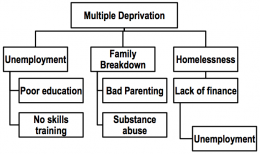
What is a Problem Tree?
When we look at a tree in nature we tend to focus on the fruit, and maybe the overall shape, the leaves and the bark. These are ways that help us define the type of tree. But if we look more closely we may notice that it looks unhealthy. To understand why, we need to look at other things. Does the soil provide adequate food? Is there sufficient depth for the roots? What are the environment and climate it lives in – exposure, wind, rainfall, sunshine etc?
A Problem Tree works the same way. We see a problem – say street homelessness – for which the obvious answer to solving the problem may appear to be more housing. However, unless we examine the underlying conditions and what has brought this homelessness into an individual’s life we are probably not going to produce a long term sustainable solution to his or her situation.
The Trunk
As with a natural tree a Problem Tree starts with the trunk, the main defining ‘structure’ which gives us the context in which we are working. So what is this for the street homeless?
Recently we carried out a planning exercise at CCK and began with developing a Problem Tree. As we discussed this trunk we felt that homelessness was too narrow – perhaps it would prove to be one of the roots. We came to the conclusion that the defining ‘structure’ was ‘Multiple Deprivation’. This gave room to consider not only the lack of a home but also the lack of family relationships, the lack of education etc.
A Problem Tree, by its very nature, is a set of negative or adverse statements. So ‘lack of’ is permissible. But this is not the final underlying problem or diagnosis. If it were it would suggest that the solution to reverse this is ‘provision of’. But that is not the case e.g. the solution to homelessness is not just about housing. We need to dig deeper and try to identify the root causes.
Examine the Roots
If we dig around the roots of a tree we may find it has a healthy root structure with many feeder roots or that it has one with a smaller number of these fibrils. If we find the latter is the case the solution is not just about food as the tree does not have the capacity to take up the necessary nutrition. We must be more radical (a word that comes from the Latin ‘Radix’ = ‘Root’) and first attend to the root structure, the channel though which food can pass.
Clearly we can drive an analogy or picture beyond usefulness and I am certainly not the one to state how the root structure of a tree can be improved! But in the case of Multiple Deprivation which has homelessness as one of its manifestations part of the ‘root structure’ may be drug addiction, alcohol abuse, broken relationships etc. these in turn may have been brought about by bad parenting, child abuse, death of a loved one in childhood etc. Only when we start to dig this deep do we begin to see that ‘homelessness’ has underlying causes and those causes need to be addressed before the conspicuous problem can be dealt with. We are talking about a very ‘sick’ tree.
Let me display this visually in a very simplified diagram that will help us see the various levels which we have identified.

If we begin on the right hand side, homelessness may have as one of its causes a lack of finance. This in turn may be caused by unemployment. Going to the left hand side unemployment may be due to poor education or lack of skills training.
In the next posting we shall look at the ‘Solution Tree’ and see how reversing the negatives can produce solutions to the main problem.
